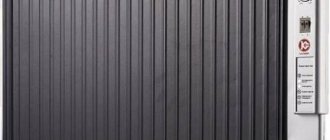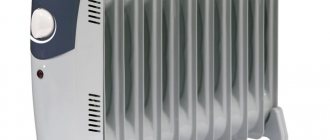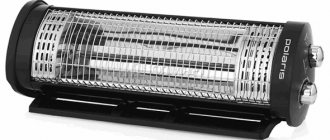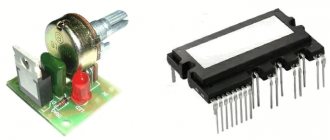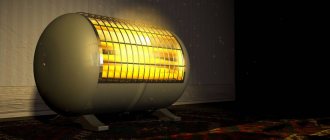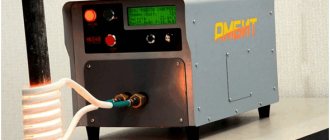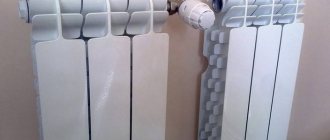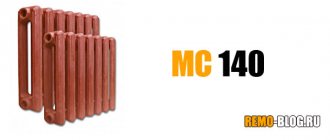Types of heaters
The modern market offers a wide selection of different heating elements:
- The simplest one is a fan heater. Needed to quickly warm up the room;
- The electric fireplace looks similar to the classic one. The difference is that it works using electric current. The fire is not real and is only aesthetic;
- The convector is very widespread because it has a simple design and relatively low cost;
- An infrared heater emits infrared waves that heat the room. This device does not harm humans;
- A carbon heater works exactly the same as an IR heater. The only difference is that instead of a quartz lamp there is a carbon carbon coil;
- Oil heaters are currently considered the most popular.
Oil heaters are divided into several main types:
- The first option is a panel device with a special reservoir in which the oil is located. In appearance, the panel itself is flat;
- The second option is sectional. It also has a tank consisting of similar sections. The design also includes a common heating element.
Panel heater Sectional device
The main advantages of panel radiators are their compactness, and when installed near a wall they will not take up much space. Sectional appliances can heat a larger area than panel appliances.
Oil radiators: characteristics, types, types
— Thermostat. A device for maintaining a constant temperature in a room. If there is a thermostat, the heater can automatically turn off when the set temperature is reached and turn on when it drops by 1-2 °C. — Temperature adjustment. Possibility of adjusting the temperature of the air leaving the heater (in fan heaters and convectors), or the temperature of the heater body (in oil radiators).
— Shutdown timer. A device for automatically turning off the heater after a specified time. The presence of a timer eliminates the need for the user to keep track of the time and turn off the heater manually: knowing the approximate time required for heating, just set the timer - and the device will turn off at the right moment.
- Programmer. The programmer allows you to competently organize the operation of the heater. Thanks to the programmer, you can set the heater to automatically turn on and off, as well as adjust the temperature depending on the time or day of the week. Using the programmer, you can configure the heating in such a way that when you leave for work, the heater will provide minimal heat, as long as the water in the pipes does not freeze, and shortly before the user arrives, it will begin to provide full heating. The programmer allows you to automate the heating process, while making it economical, rational and efficient.
— Thermal ventilation (convectors). The presence of an additional fan in the design of an oil heater or convector (see “Type”). This fan provides forced air circulation, which speeds up the heating of the room and increases the efficiency of the device. Note that fan heaters (see ibid.) have this function by definition, so its presence is not indicated for them.
— Ventilation without heating. The ability to operate a fan heater or other device with a fan (see above) in normal ventilation mode, when the heater is turned off and air passes through the device without heating. This mode can be useful, for example, in warm weather, when there is no need to warm up the air. Of course, the efficiency of such devices is noticeably lower than that of full-size specialized fans, but in many cases it is quite sufficient.
— Rotary system. System for automatic rotation of the heater body during operation. This allows you to increase the heating zone and ensure more uniform heating of the room. Most often, fan heaters and IR heaters are equipped with this function.
- Fireplace effect. It is used in oil radiators to improve air circulation and warm up the room faster. Special slots are made on the body of the device, creating traction and enhancing natural convection.
- Moisturizing. An increase in indoor temperature leads to a decrease in relative humidity. This has an adverse effect on people's well-being. To prevent this, some heater models are equipped with air humidification devices, consisting of a water tank and an evaporator.
- Ionization. Ions are electrically charged molecules. It is believed that the presence of negatively charged ions in the air has a beneficial effect on human health and general well-being. Ionizers are used to saturate the air with such ions.
- Remote control. Availability of a remote control included in the delivery set of the heater. The convenience of this function is obvious: the remote control allows you to control the heater from a distance, literally “without getting up from the couch.” This comes in especially handy, for example, on a cold morning, when crawling out from under the blanket into an unheated room would be extremely uncomfortable. Also note that in models with advanced functions (such as a timer), control of these functions can only be accessed from the remote control.
— Control from a smartphone. The ability to use the user's smartphone as a remote control. By installing the manufacturer’s proprietary application, you can change the operating mode, adjust the temperature and other device parameters directly from your phone.
— Connecting a Wi-Fi module. The ability to expand the capabilities of the heater when connecting a Wi-Fi module (not included). With its help, control from a smartphone becomes accessible.
- Display. Availability of a display in the heater design. Usually this is a simple black and white screen with a few characters, but even this in this case is enough - almost all the key information about the operation of the device can be displayed on this screen: temperature, timer settings, problem notifications, etc. Thanks to this, control becomes more convenient. convenient and visual.
Operating principle and design
The design of the device includes a housing, a heating element (heating element) and a control panel. The oil heater operates from the mains. When you turn on the device, the heating element first starts working and, when heated, transfers heat to the oil, and then in turn heats the housing, which warms the air. Many models can heat up to 150 degrees, so it is not recommended to touch the device during operation. The oil is filled only to 85% of the full volume, since when heated it expands and needs free space.
Oil heater design
Advice! Never allow small children close to the heater, as the risk of getting burned is very high.
Previously, every oil heater had valves through which oil was poured. Modern designs do not have it, and the filled oil cannot be changed or topped up. Also, the device is not intended for hanging on a wall.
Advantages and disadvantages
Oil heaters are in great demand among consumers, as they have a number of advantages:
- smoothly and constantly maintain heat inside the heated room;
- low risk of fire;
- reliable, as they are made of durable materials that are resistant to corrosion;
- an option with special protective grilles is possible if there are children or animals at home;
- no noise;
- do not dry the air;
- no additional maintenance required;
- have mechanical and electrical protection systems;
- suitable for almost every room, since high power is not required;
- do not produce unpleasant odors;
- low price;
- mobile (has legs on wheels).
The device also has several disadvantages:
- Some cheap units may be equipped with a fan to quickly warm up the room, but this creates noise;
- The cheapest models can also be made from low-quality materials. Among the devices, first of all, you need to pay attention to those whose body is made of galvanized, anodized or other stainless metals;
- A narrow model may be unstable;
- Some units may not have temperature control.
Oil and other electric heaters
What distinguishes oil radiators from conventional convector electric heaters and other common devices is their ability to store heat. This task is performed by the oil that fills the device. It heats up and then returns the accumulated heat over time. This period is not very long and usually does not exceed three hours, but still this property allows us to save money if our apartment or house is equipped with a multi-tariff electricity meter. To reduce costs, oil heaters can be turned on at lower night electricity rates or at more favorable times during the day in terms of tariffs, and it is better to turn off the device during peak periods. This will ensure optimal energy use.
Oil radiators will be a very advantageous source of heat as a backup in the event of a central heating failure or when a room needs to be warmed up more quickly. In addition, they can be used in the off-season or in rooms and areas that require only short-term heating.
When a cold wind blows through the window or it rains, we often turn to an additional source of heat for help. Living in a separate house, we have the opportunity to turn on the heating when we feel cold, which is impossible to do in apartments with central heating. We cannot influence the time when central heating is turned on and the start of the heating season. Therefore, additional backup heat sources are very useful.
This device, of course, will not replace central heating. We would have to buy several of these devices, which would require a lot of energy and expense. However, this device is ideal for periodically heating rooms such as bathrooms, garages, and attics. High mobility allows us to heat the air only where it is really needed. Oil heaters can also be indispensable where there is no heating system, for example, in gazebos, kiosks or shops. We don't need a chimney or fuel source to operate them. Electric heaters are available at affordable prices and are quite energy efficient. The big advantage of this solution is that installation does not require much work. We don't need to lay pipes or tear down walls. Plus, installing an electric heater only takes a few minutes and can be done by anyone.
Types of oil heaters
When choosing a heater, you also need to pay attention to the design profile. It can be ribbed or flat.
Ribbed
Ribbed oil heaters are shaped like the usual cast iron radiators, as they are also made of many sections. Sections of the electrical device are made by welding and further pressing. Most often, the thickness of steel can vary from 0.8 to 1 mm. Tightness is achieved thanks to laser cutting, which very accurately and evenly makes the required dimensions. High temperature also does not deform the body or joints.
Finned Oil Heater
After the body is made, holes are cut into it, passing through each individual section. This is done for their communication with each other. Once the device is technically ready, it is painted with powder paint and then placed in an oven to polymerize the coating.
This type of housing makes the device durable and efficient, since it has more area for heat transfer. True, in this case the oil heater will have considerable weight and a fairly large structure.
Flat
Flat heaters are two plates welded together, which have recesses on the body for heating elements and oil. This device is less efficient, but it also consumes less electricity. In addition, a flat heater does not have as much weight as a ribbed one and therefore can be mounted on a wall.
A flat oil heater can be made of steel, aluminum or an alloy of these metals. Steel appliances tend to be heavier and can cause damage if dropped. Aluminum is lighter, but less powerful.
Flat heater can be wall mounted
The most expensive devices are those made of aluminum and steel.
Important! Bimetallic devices may make a cracking sound when heated or cooled. This is due to the difference in thermal expansion between steel and aluminum.
Design and principle of operation of an oil heater
The main element of an oil heater is the radiator. This element is made of ferrous metal, which has a thickness of 0.8-1 mm. All elements in heaters must be thin, so a laser is used to cut metal, which leaves a smooth surface and even edges. And to make right angles, a sheet bending device is used. And small details are stamped.
In order for each section of the heater to be airtight, all parts must be welded together and then pressed into place. But first you need to make holes that allow you to assemble the heaters from separate sections. The radiator is painted using powder technology and then polymerized by heating in an oven. That is why this paint is very durable.
After the heater is assembled, you need to fill it with transformer mineral oil. In previous models, a separate valve was installed to fill the oil, but in modern heaters, filling occurs during assembly. Panels made of metal and plastic are installed outside, which are equipped with thermostats, an overheating protection device and a power regulator, and an electric heater is installed inside. You also need to connect the power cable.
To make it easier to move the heater, it is fashionable to attach the wheels with a bracket with nuts.
Let's look at the operating principle of an oil heater:
• After the heater has been turned on, you need to set the required temperature in the room using the regulator. The heating element heats up first, and then the heat is transferred to the mineral oil. With the help of oil, the radiator body is heated and thus the heat spreads throughout the room$
• The operating principle is convection. Heated air rises and cold air falls down to heat up. Only the radiator fins can be heated using radiant thermal radiation.
Installation method
Oil heaters can be mounted on a wall, installed on the floor or on a table.
Wall mounted
Wall heaters are flat in shape and light in weight. They are mounted on the wall in the place where there is a protective screen so that the heat from it is reflected and returned to the room. Typically, such devices are more expensive due to the reduced temperature system, which is necessary to reduce the risk of fire; increased demands on performance as well as beautiful appearance.
Floor-standing
A floor-mounted oil heater is often bulky and heavy, as it is made of steel. The device cannot be mounted on a wall due to its large weight, volumetric shape, and loss of heat transfer from the side of the attached wall. Floor-standing options are stationary, but many models have legs if you need to move them to another room.
Tabletop
The desktop version is the weakest in terms of power. Very rare and very unpopular.
Main selection criteria
There is a wide selection of different electrical appliances on the market with a wide range of options. However, in order to make the right choice, you first need to decide on the basic selection criteria.
Power
When choosing a heating unit, first of all, attention is paid to its power. This parameter can vary from 0.5 to 3 kW. Most often you can find devices with average power - this is 1.5-2 kW.
To choose the right power for a room, you need to assume that 1 kW equals 850 W of heat. This will be enough to heat a room with an area of 10 m2. A 2 kW device is suitable for a room of 20 m2. Approximate calculations are given below.
| Room area, m2 | Oil heater power, kW |
| 4-5 | 0,5 |
| 5-7 | 0,5-0,8 |
| 8-10 | 1 |
| 10-12 | 1-1,2 |
| 12-14 | 1,2-1,5 |
| 15-16 | 1,5 |
| 17-18 | 1,7 |
| 18-20 | 2 |
| 20-22 | 2-2,2 |
| 22-25 | 2,2-2,5 |
| 25-27 | 2,5 |
The choice of power also depends on the capacity in which the heater will be used - as a main heater or as an auxiliary one. In the case of the second option, experts recommend reducing the power by half. The above table also assumes standard ceiling heights. If they are higher, then, accordingly, the power must be increased.
Choose a heater depending on power
You also need to pay attention to the following factors:
- the presence of external walls in the room, material of manufacture and degree of insulation;
- when installing the device under a window sill or niche, it reduces its efficiency by 5-7%;
- the size and type of windows also plays a role - the larger the window, the more heat it lets in;
- The location of the room on the south side allows it to be heated by sunlight even in winter.
Important! If a 3 kW unit is needed, but only devices with 10 sections or more are available, then it is better to choose several options that can reach 3 kW in total, since devices with more than 10 sections do their job worse.
- Low-power (0.5-1 kW). Devices with a power of 0.5 to 1 kW most often act as an auxiliary heater or in the case of heating small rooms with an area of 4 to 10 m2. They have a lower cost than medium and high power units;
- Average power (1-2.5 kW). An oil heater with medium power can act as the main heating device. Such a unit is capable of heating 10-25 square meters of area. Models with this power can be expensive if they have additional features;
- High power (2.5-3 kW). These units are purchased not only for home use, but also for heating office premises with an area of 25-30 square meters. They are quite heavy and bulky. For this reason, moving them is very difficult. They have a high cost.
Size and material
Modern oil heaters can have from 5 to 14 sections. The more sections the device has, the faster it will heat the room. In this case, energy consumption will be higher.
The best option is a heater with 7 sections. Such a device is capable of warming up a medium-sized room.
Oil heaters are made from the following materials:
- Steel. Steel heaters are usually heavy. Ribbed and flat units are made from this material. A steel heater can reach temperatures of up to 150 degrees and is therefore not recommended for homes with children or pets. Also, due to its high weight, it cannot be mounted on a wall;
- Aluminum. Aluminum appliances have low power. Their light weight allows them to be hung on the wall;
- Alloy of steel and aluminum. Expensive heating devices can be made of two metals, the characteristics of which are very different from each other. The inner layer of the body is made of steel, and the outer layer (ribbed or smooth) is made of aluminum. The steel layer makes the device more durable, and the aluminum layer transfers heat better and warms the air.
A steel appliance heats better than an aluminum one
Number of heating elements (heating elements)
A unit with one heating element can be used as the main heating device with the required power. However, the power may be too much and the room may be too hot.
A device with two heating elements is more convenient, since its functionality is wider. If necessary, you can turn off the second heating element.
Power mode switch
A very convenient option that allows you to regulate the heating power of the room. Almost any oil heater has power adjustment. The cheapest ones have two modes.
The best option is considered to be a device that has three modes - a weak heating element, a powerful heating element, two heating elements. There are also models that have smooth power adjustment.
DESIGN AND CHARACTERISTICS
The power of household devices on the market is usually 0.5–3 kW. The standard power step is 0.5 kW, although other options are possible.
There are several principles for selecting an oil heater for a specific room, however, if you do not want to carry out calculations and look for a suitable model, you can settle on the standard and most common power of devices - 2 kW.
The design of radiators of this type is standard, and manufacturers do not make significant changes to it.
Among the minor design features of different heater models are:
- the presence of handles for carrying;
- wheels or slides for moving on the floor;
- heat-insulating casing.
Handles are not a mandatory element, but are provided in almost all modern devices; All radiators have wheels or skids, depending on the model.
If possible, you should purchase devices equipped with protective covers: this will avoid serious burns that occur when coming into contact with the surface of the device. A high-quality casing is especially important when installing the device in a children's room. The only disadvantage of such insulation is the difficulty in cleaning the radiator grilles.
It is necessary to pay attention to the number and size of sections of the apparatus. Narrow sections (ribs) heat up faster themselves, but due to the small heat exchange surface they slowly warm up the environment; After switching off, appliances with narrow fins take longer to cool down, continuing to heat the room.
Wide sections, although they heat up more slowly, transfer heat to the external environment much better, and the room warms up faster.
At the end of the heater operation, such sections cool down faster than narrow ones. In addition, devices with narrow fins consume less electricity, which allows us to talk about them as more energy efficient devices.
Additional functions vary for each commercially available model; each residential owner can choose the ideal combination of heater options for himself.
Modern devices may have the following elements in their design.
Heating mode switch
or temperature controller, giving users the opportunity to choose the operating power of the device, and therefore the room temperature.
Timer
on/off, with which you can heat the room in advance, before people arrive, or leave the device in working condition, without fear of excessive energy consumption.
Humidifier
, relieving the occupants of the room from the main disadvantage of oil radiators - dry air. It is a container with water that evaporates during the operation of the heater.
Fan heater
, activating heat exchange in the room due to mechanical distillation of air masses.
Fireplace effect
— thermal slots that accelerate heat transfer from the surface of the device to the air by almost half.
overheat protection
— the most important option that increases the fire safety of the device. It turns on when the permissible temperature value on the heating elements is exceeded.
Dryer
, which makes it possible to use the thermal energy released by the device into the air to dry wet things without the risk of fire. It should be remembered that drying any products directly on the radiator body is strictly prohibited.
Additional features
- Almost every heater has a light indicator. It shows when the heating element is working. When the room temperature reaches the desired temperature, the heating element stops heating and, accordingly, the indicator goes off;
- The thermostat can be mechanical or electronic.
The mechanical option is more reliable and in case of malfunction it can be easily and quickly repaired without large financial costs. An electronic temperature controller is more expensive, as its functionality is much wider. For example, you can program operation at certain times of the day or even days of the week. In addition, it more accurately maintains the set temperature; Mechanical thermostat Electronic thermostat - Overheating protection will prevent fire. If the heating element starts to overheat, the protection will automatically turn it off;
- When heated, the oil expands and if it heats up above the permissible temperature, the radiator may rupture. To prevent this from happening, good heaters are equipped with boil protection. The protection itself is a two-component sensor, which, when overheated, breaks the circuit and disables the fuse, the replacement of which will not hurt your pocket;
- The timer allows you to set the operating time of the device. If you want to come home from work to an already heated house, you need to set the timer for the work time two hours before returning;
- An air humidifier solves one of the main problems of heaters - air dehumidification. The design is very simple - there is a container with water on the radiator. When heated, the water begins to evaporate and due to this the air is slightly humidified;
- The fan heater allows you to warm up the air faster. It is installed inside the device and releases streams of warm air during operation;
- Many users dry things directly on the heater, but this is prohibited by safety rules. Therefore, a removable clothes dryer solves this issue.
Important! You cannot turn on the heater if the overheat sensor does not work. The unit will increase in temperature without stopping, which can lead to rupture of the housing. If you ignore this rule, there is a risk of fire.
The best oil heaters up to 2 kW
Timberk TOR 21.1809 BCX i
4.9
★★★★★
editorial assessment
100%
buyers recommend this product
See review▶
A 9-section heater with a power of 2000 W can heat the air in a room of up to 18 sq.m. in half an hour. The device has a built-in air ionizer, a switch with an LED, frost protection, and an overheat shutdown system. The weight of the device is only 6.5 kg.
Pros:
- low price;
- mobility;
- lightweight for its size;
- ionization function;
- frost protection.
Minuses:
- There is no thermal protection for the case.
Timberk TOR is suitable for rooms with high humidity. It will perform well in the country and in an unheated room, since it is not afraid of freezing. And in living rooms, the heater will create a comfortable microclimate and saturate the air with useful ions.
Polaris PRE W 0715
4.9
★★★★★
editorial assessment
98%
buyers recommend this product
See review▶
The heater is suitable for rooms up to 15 sq.m. The power regulator allows you to save electricity by choosing the optimal value for warming up. Operating modes – 600/900/1500 kW. The device has 7 sections, overheating protection, mechanical control and a switch with an indicator light.
Pros:
- fast warm-up;
- compact dimensions;
- low power consumption.
Minuses:
- small heating area.
The device is suitable for heating small residential premises, storage rooms and small retail pavilions.
READ ALSO
10 best outdoor heaters
Hyundai H-HO9-07-UI847
4.8
★★★★★
editorial assessment
96%
buyers recommend this product
See review▶
A high-quality and inexpensive heater is ideal for small rooms up to 15 sq.m., since the power of the device is 1500 kW. The heater is relatively light (5.3 kg), compact, with wheels for movement. The protective casing does not heat up during operation.
The functionality includes a thermostat, a switch with an indicator light, a fireplace effect and a mechanical temperature controller.
Pros:
- small sizes;
- light weight;
- affordable price.
Minuses:
- short cord.
A good and relatively inexpensive heater for small and medium-sized rooms.
Unit UOR-721
4.8
★★★★★
editorial assessment
92%
buyers recommend this product
See review▶
A small 7-section heater of medium power (1500 W) evenly warms a room of 15 sq.m. and keeps warm for a long time. This is a budget model with a set of standard functions, which includes mechanical control, power mode adjustment, light indicator on the switch, fireplace effect and overheating protection. Additional amenities include a cord compartment, a handle and wheels for easy movement.
Pros:
- uniform heating;
- reliability in operation;
- low price.
Minuses:
- thin metal body.
Unit UOR is worth considering as an auxiliary heater. This is a good choice for small spaces that lack heat from central heating.
Hyundai H-HO10-09-UI846
4.8
★★★★★
editorial assessment
92%
buyers recommend this product
Reliable low-power 5-section heater designed for 10 sq.m. It does its job well, lasts a long time, and weighs little - about 4 kg. The functionality is standard: thermostat, overheat protection, switch with a glowing indicator, mechanical control regulators.
Pros:
- compact;
- good assembly;
- easy.
Minuses:
- no handle to move.
An excellent heater for small cabins, trailers, workshops, balconies, verandas and office premises.
Scarlett SC 41.1005
4.7
★★★★★
editorial assessment
89%
buyers recommend this product
See review▶
A small 5-section heater with a power of 1000 W is capable of maintaining a comfortable temperature in small rooms. This model weighs 5.5 kg. A distinctive feature of the device is a sensitive copper thermostat. The set includes mechanical temperature control, a switch with indicator, wheels, a cord compartment and a handle.
Pros:
- excellent warm-up;
- high build quality;
- light weight.
Minuses:
- no overheat protection.
A low-power heater, of course, will not cope with the task of independent heating, but as an auxiliary device it is good and also economical.
READ ALSO
10 Best Ceramic Heaters
Rating of the best heaters
Budget models
| Model | Characteristics |
| Vitek VT-1704 It has the optimal number of sections - 7. Suitable for heating rooms with an area of up to 20 m2. It has a built-in fan that allows you to raise the temperature even faster. At the same time, electricity consumption increases slightly. Price - 2,900 rubles. Positive sides:
Negative sides:
| |
| General Climate NY12LA You can buy this equipment for only 1,550 rubles. Power consumption - 1200 W. This option is suitable for heating a small office or room with an area of 15 m2. The unit consists of 6 sections, has a smooth switching of the heating level and a special compartment for the cord. It is mobile because it has wheels. Pros:
Minuses:
| |
| Royal Clima ROR-C7-1500M Catania It is simple, light and convenient. The power of the device is 1500 W, which allows you to heat rooms with an area of 20 square meters. The optimal number of sections will allow you to heat the room evenly and quickly. Thanks to the wheels and non-heated plastic handle, the unit can be easily moved from room to room. You can control the degree of heat using the temperature regulator. As soon as it heats up to the maximum temperature, it will automatically turn off while continuing to give off heat. The cost of the device is 2,200 rubles. Advantages:
Disadvantages: heavy weight (7 kg). |
Middle price segment
| Model | Characteristics |
| RESANTA OM-09N It is a fairly simple device that is designed to heat medium and large rooms. The power of the device is 2000 W. The 9-section equipment weighs quite a lot - 9 kg, but despite this, it moves easily on wheels. It is easy to use - all you need to do is turn the thermostat knob and when the desired temperature is reached, the device itself will automatically turn off when the required air temperature is reached and turn off when it is reached. Price - 3,200 rubles. Pros:
Cons: heavy. | |
| Timberk TOR 31.1907 QT In almost all respects it is similar to other oil heaters. The main difference is the presence of the Steel Safety system, which protects equipment from oil leaks. The device has 7 sections with a power of 1900 W. Its advantage is also the presence of a fan, with which the air can be heated faster. The unit costs 3,100 rubles. Advantages:
Flaws:
| |
| Timberk TOR 51.2009 BTM It has an unusual wavy shape, which makes the device more attractive in appearance. However, such a design solution also has a practical benefit - a large heating area of the device, which implies greater heat transfer to the room. The power of the unit is 2000 W. This oil heater can easily maintain room temperature in a large room. Price - 3,900 rubles. Pros:
There are no cons. |
Advice! When purchasing equipment, you should pay attention to the material from which the rollers on the legs are made. Plastic ones can scratch the floor surface, so it is better to choose among rubberized ones.
Premium models
| Model | Characteristics |
| UNIT UOR-123 This is a high-power device with 11 sections, but at the same time it has a fairly compact size. The power adjustment has three stages, in which the highest is 2300 W. If the unit gets too hot, it will automatically turn off, but will continue to give off heat. Thanks to 11 sections, it has a large surface area that quickly warms the air. Positive sides:
Negatives : none. | |
| Timberk TOR 31.2912 QT Ideal for rooms with an area of 28 m2 or more. The unit has 12 sections and a power of 2900 W. Having such a number of sections, the weight of the device is only 12 kg. In addition, the heater has a built-in fan that will help heat the room even faster. To correctly select the desired temperature, a three-level power regulator is included in the package. There is protection against oil leakage. Price - 4,700 rubles. The device has the following main advantages:
There are also disadvantages: loud fan operation. | |
| UNIT UOR-993 The first thing that catches your eye is its beautiful appearance. The device can be black or white. Power is 2000 W and 8 sections. The control of the device is completely electronic, there is a remote control. For more convenient operation there is a display. There are also options such as a thermostat, timer (24 hours), temperature adjustment, switch with indicator light and delay start. An additional feature of the device is the ECO automatic power control mode. The mobility of the device is confirmed by the presence of wheels and a handle. Among the protective functions there is a shutdown when overheating. Cost - 6,500 rubles. Pros:
Minuses:
|
Best Low Power Oil Heaters
Budget
Elterm ERMPT-0.5 is a simple floor-standing model equipped with options in the minimum required quantity. When heated above 105 °C, the electric radiator turns off, as indicated by the light indicator, and automatically begins to function after cooling. For ease of movement, a handle is provided.
Advantages:
- N: 0.5 kW;
- S = 5 sq. m.;
- 3D: 0.16 x 0.61 x 059 m;
- C/V: ≈1.0 thousand ₽ / 3.0 kg;
- heats according to the documentation; minimally consumes electricity; takes up little space;
- easy to operate and maintain; costs little.
Flaw:
- does not exceed expectations, which is essentially not a minus.
According to reviews: a good economical device that punctually performs its functions in a small area.
Recommendations when choosing
- It is best to give preference to the model that has wheels and handles. This will make it easier to move the device as needed;
- A good oil heater has an impressive weight. Light weight indicates thin walls or insufficient oil. Both options lead to premature failure;
- If there is a small child in the house, then a special casing is put on the device, which will protect against burns;
- The length of the cord also plays an important role. If the cord is too short, you will have to use an extension cord, which will not always be able to withstand the voltage and will eventually begin to melt, which will lead to a short circuit, and subsequently to a fire;
- It is undesirable to listen to the recommendations of consultants, since for their own benefit they can sell less popular products, guided by false arguments (“black transfers heat better” or “this” option does not raise dust”, and so on).
Watch a video on how to choose an oil heater
